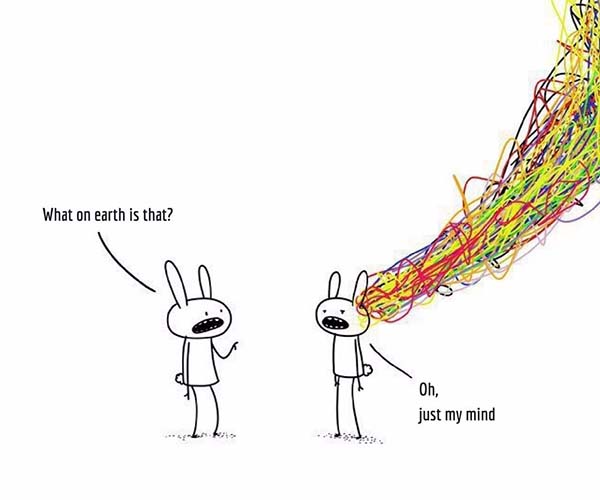
I’ve had anxiety as long as I remember. As a kid I worried about everything. My well-meaning parents always told me not to worry which is akin to my husband (who I adore by the way) telling me to “calm down” if I get really upset over something (‘cos why didn’t I think of that?).
As much as we’d love to, we can’t control what we think and feel. Not really.
Truth is, we have much less control over what we think and feel than we’d like (and are led to believe). And telling an anxious kid “don’t worry” does. not. help. If anything, and I’m speaking from experience here, trying hard as a kid (or an adult for that matter) to ‘not worry’ and think of ‘something else’ or think about ‘something fun’ is futile. Trying and failing at this everyday as a kid just gave me something else to worry about. That everyone except me could control their thoughts and sail through the day unfazed. It just made me feel worse.
My mind was a tangled mess and I didn’t have any skills to deal with it. Nor did my parents. How would they? Who even knew about anxiety in the early 80’s?
Worry – it’s not all doom and gloom
Worry serves a purpose to a certain extent, it can really motivate us to get things done. Worrying about the engine light that recently appeared on your car’s dashboard will likely motivate you to take your car to the mechanic. Worrying about your family history of diabetes will hopefully motivate you to take better care with what you eat and how much you move. A child who is worried about a test might be motivated to prepare more in advance.
But then there’s another type of worry. The worry that’s all-consuming. The type that appears everywhere you turn. They’re the worries that interfere with sleep, can turn your stomach and can make life miserable. It’s awful. We’ve all had them from time to time. But for those of us with anxiety, without the skills to handle our thoughts and feelings, these can be a daily, even hourly challenge to contend with. As parents of kids who experience this, it’s horrendous to watch and can make us feel powerless and filled with anxiety ourselves. All that we can do to help our kids we can do for ourselves too, which helps us remain calm when they need us the most.
Thinking about thinking – we do it all the time!
As adults we can often recognise the worries that are pulling our thoughts away from what we’re doing, that is, when we’re not completely lost in them. To be able to notice what you’re thinking is actually a skill called metacognition. Thinking about thinking begins to develops significantly in kids from around 4 years old but research shows that even toddlers as young as two can actually understand the expectations of another person and foresee how they will feel when their expectations are not met.
That said, conversations with our kids about what’s going on in their minds start to get really interesting from around the age of 7. And the older they get, the more they can use their powers of metacognition; a fundamental step in being able to untangle their thinking.
Untangling from thoughts requires regular practice of key skills. In the same way that our kids would regularly train to prepare for a competitive sport, there are thinking skills to practice (pre-match training) that prepare them for the tough times when anxiety strikes (game day).
Untangling from worrying thoughts takes practice, here’s some training ideas;
1) Start by inviting your kids to name their mind.
This way, to get an idea of what they’re thinking, you can ask them what ‘George’ is saying or ‘Daphne’ (our daughter’s name for hers!). Some of the names kids come up with are hilarious but try not to laugh!
2) Practice awareness of the present moment often.
For primary school aged kids you can do this for a minute or two a few times a day, for older kids, bump up the length of time. Here’s a few ideas:
- Play the 5-4-3-2-1 game where you sit or lay quietly and take a few minutes to notice 5 things you can see, 4 things you can touch, 3 things you can hear, 2 things you can smell and where possible, one thing you can taste.
- Face each other and mirror each other’s movements, hands feet, body, anything!
- Use an app like Smiling Mind to practice a mindfulness exercise
- Sit quietly and do some box breathing where you breathe in through the nose for a count of 3, hold for a count of 3, breathe out for a count of 3 and hold for a count of 3, in for a count of 3 etc. (or 4 or 5 counts, whatever feels comfy), note how the temperature feels different on the out breath through the nostrils. Mouth breathing fine too.
3) Play the ‘Milk, Milk, Milk’ game.
Ask your child to tell you everything they can about milk. Colour, temperature, taste, where it comes from. Anything they can think of that brings meaning to the word. Now spend the next 1-2 minutes together saying the word ‘milk’ over and over (and over) again fairly quickly until it loses all its meaning. Talk about how you both felt as you kept saying it over and over. Eventually it’s just a sound. The purpose of the game is to demonstrate that all words are like that.
Using the ‘Milk, Milk, Milk’ tactic on ‘game day’ reduces the power thoughts have over our kids. It takes the ‘sting’ out of the experience of thinking those thoughts and stops the thoughts from pulling the kids into a tangled, anxious state. If as a family you regularly notice and talk about your minds (George, Daphne etc.) and what they’re saying to you, it’s easier to tap into the specifics of anxious thoughts when they pop up.
Now it’s game day, putting new skills to practice
Let’s say, for example, that your child is feeling super worried about something. It’s game day, they’re anxious but they’ve done their training so are ready.
1) Start with box breathing while walking.
Getting them moving and breathing purposefully will begin to calm the part of the mind that’s on high alert (the amygdala).
2) What’s their mind saying?
As they calm down ask them what ‘George’ or ‘Daphne’ is saying so you can hopefully get clear on the specifics of the anxiety (but do remember, some anxiety pops up and they just won’t know why – if this happens, continue with the breathing and the walking). And stay calm (or pretend), over time they’ll learn to internalise your reaction.
3) Use the ‘Milk, Milk, Milk’ tactic for their anxious thought.
Let’s say it’s anxiety over an upcoming test and the thought is “I’m hopeless at spelling”. Together repeat the sentence over and over fairly quickly for a minute or two. It’s a little painful for them at first but by the end of the exercise the thought loses its power and they can begin to see it for what it is, just a bunch of words strung together.
4) The silly voice game – sounds ridiculous but works a charm
They have to muster up their silliest voice and repeat their anxious thought a handful of times out loud in that voice. Everyone usually ends up laughing.
5) So what next?
Ask them not to question whether their thought is right or wrong, but to ask “is it helpful?” When they say “no” ask what would be helpful and direct them towards actually doing something that moves them towards a goal that matters to them (practice their instrument, shoot a few hoops, practice a dance routine, play with their pet, arrange a play with a friend) etc.
These strategies help our kids to learn to look at their thoughts instead of from them. Grounded in science, it’s all about learning to handle difficult thoughts and feelings in a new way. A way that you as a parent can teach and support and enable. It’s the way I’ve learned to manage my own thinking using similar strategies and moving forward to create a vibrant, meaningful, happy life. Anxiety doesn’t have to put our kids on the bench, they can learn to handle their worries and live an amazing life despite it.


about
Jodi is on a mission to elevate mental health and wellbeing in families, classrooms and workplaces.


free 5-day
Calm your anxious brain
mini course

Recent Posts

free 5-day
Calm your anxious brain
mini course
Sign up for my free 5-day ‘Calm Your Anxious Brain’ email mini-course. Put the strategies into place for yourself, light the way for your kids, or do both.






